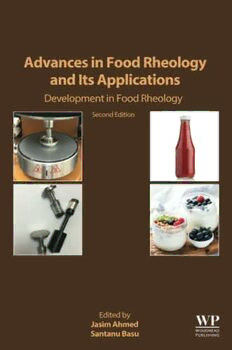
Advances in Food Rheology and Its Applications: Development in Food Rheology PDF
Preview Advances in Food Rheology and Its Applications: Development in Food Rheology
Advances in Food Rheology and Its Applications Development in Food Rheology Advances in Food Rheology and Its Applications Development in Food Rheology Second Edition Editor Jasim Ahmed Associate Editor Santanu Basu WoodheadPublishingisanimprintofElsevier 50HampshireStreet,5thFloor,Cambridge,MA02139,UnitedStates TheBoulevard,LangfordLane,Kidlington,OX51GB,UnitedKingdom Copyright©2023ElsevierLtd.Allrightsreserved. Nopartofthispublicationmaybereproducedortransmittedinanyformorbyanymeans, electronicormechanical,includingphotocopying,recording,oranyinformationstorageand retrievalsystem,withoutpermissioninwritingfromthepublisher.Detailsonhowtoseek permission,furtherinformationaboutthePublisher’spermissionspoliciesandour arrangementswithorganizationssuchastheCopyrightClearanceCenterandtheCopyright LicensingAgency,canbefoundatourwebsite:www.elsevier.com/permissions. Thisbookandtheindividualcontributionscontainedinitareprotectedundercopyrightbythe Publisher(otherthanasmaybenotedherein). MATLABsisatrademarkofTheMathWorks,Inc.andisusedwithpermission.TheMathWorks doesnotwarranttheaccuracyofthetextorexercisesinthisbook.Thisbook’suseordiscussion ofMATLABssoftwareorrelatedproductsdoesnotconstituteendorsementorsponsorshipby TheMathWorksofaparticularpedagogicalapproachorparticularuseoftheMATLABs software. Notices Knowledgeandbestpracticeinthisfieldareconstantlychanging.Asnewresearchand experiencebroadenourunderstanding,changesinresearchmethods,professionalpractices, ormedicaltreatmentmaybecomenecessary. Practitionersandresearchersmustalwaysrelyontheirownexperienceandknowledgein evaluatingandusinganyinformation,methods,compounds,orexperimentsdescribedherein. Inusingsuchinformationormethodstheyshouldbemindfuloftheirownsafetyandthesafety ofothers,includingpartiesforwhomtheyhaveaprofessionalresponsibility. Tothefullestextentofthelaw,neitherthePublishernortheauthors,contributors,oreditors, assumeanyliabilityforanyinjuryand/ordamagetopersonsorpropertyasamatterof productsliability,negligenceorotherwise,orfromanyuseoroperationofanymethods, products,instructions,orideascontainedinthematerialherein. ISBN:978-0-12-823983-4(print) ISBN:978-0-12-823984-1(online) ForinformationonallWoodheadPublishingpublications visitourwebsiteathttps://www.elsevier.com/books-and-journals Publisher:NikkiP.Levy AcquisitionsEditor:MeganR.Ball EditorialProjectManager:MarianaL.Kuhl ProductionProjectManager:SuryaNarayananJayachandran CoverDesigner:GregHarris TypesetbyMPSLimited,Chennai,India Contents Listofcontributors xvii Foodrheology:Scientificdevelopmentandimportancetothe foodindustry xxi Part I Advances in Food Rheology 1 1. Interfacial rheology of food: protein as a model food 3 NoemiBaldino,OlgaMileti,FrancescaLupi(Romana)and DomenicoGabriele 1.1 Introduction 3 1.2 Interfacialrheology:basicconceptsandcharacterization techniques 5 1.2.1 Dilatationalinterfacerheology 6 1.2.2 Shearinterfacerheology 7 1.3 Proteinsatfoodinterfaces 8 1.4 Interfacialrheologicalanalysis 12 1.5 Vegetableproteins:thenewtrendinthefoodindustry 17 1.6 Foamsandemulsionsinfood:theroleoftheproteins 19 1.7 Conclusions 22 References 22 2. Rheology and food microstructure 27 S.KasapisandA.Bannikova 2.1 Solutionrheology 27 2.2 Oscillatoryshearrheology 30 2.3 Thecascadeapproachingelationtheory 34 2.4 Low-solidmixedsystems 37 2.5 High-solidsystems 43 2.6 High-pressureeffectsonglobularproteinsystems 48 References 56 v vi Contents 3. Dynamics of thixotropic liquids and time dependency 63 M.HousˇkaandR.Zˇitny´ Symbols 63 3.1 Introduction 64 3.1.1 Thixotropy 64 3.1.2 Definitionsofthixotropyandrelatedbehavior, includingantithixotropyandrheomalaxy 64 3.2 Rheologicalmodelsofthixotropicfluids 65 3.2.1 Structuralmodelswithadifferentialkineticequation 65 3.2.2 Structuralmodelswithanintegralofdeformationrate history 66 3.2.3 Presentationofspecificconstitutivemodel 67 3.3 Identifyingtheparametersforaselectedmodelof thixotropicbehavior 67 3.3.1 Rheologicalexperimentconditions 67 3.3.2 Nonlinearregressionofexperimentalshearstress versustimedatabyselectedmodelequations 68 3.4 Examplesofrealthixotropicfluids 69 3.5 Applicationsofrheologicalmodelsofthixotropicbehaviorfor solvingselectedengineeringtasks 70 3.5.1 Startinguparotationalrheometer 70 3.5.2 Isothermalstationaryflowofathixotropicfluidina horizontalcirculartube 70 3.5.3 Poweroftheanchoragitatorinthecreepingflowregime 73 3.6 Futuretrendsinthixotropicfluidmodeling 75 3.7 Conclusions 75 Acknowledgment 76 References 76 4. Rheology to tribology: applications of tribology in studying food oral processing and texture perception 81 S.Prakash 4.1 Introduction 81 4.2 Tribometer—principle,operation,measurementof lubricationpropertiesanddifferenttypes 83 4.2.1 Basicprincipleofatribometer 83 4.2.2 Operationofatribometer 84 4.2.3 Measurementoflubricationpropertiesoffoodproducts 84 4.2.4 Varioustribometersusedinfoodapplications 86 4.3 Sensoryperceptionandtribology 95 4.4 Conclusions 100 References 101 Contents vii 5. Large amplitude oscillatory shear measurement and Fourier-transform rheology: application to food 105 P.Ptaszek 5.1 Introduction 105 5.2 LAOSmethodsanddataanalysis 106 5.2.1 G0,GvCurves 106 5.2.2 AnalysisofG0 andGv 107 5.2.3 TimeseriesanalysisandFouriertransformrheology 110 5.2.4 SimpleLissajousfigures 113 5.2.5 ExtendedanalysisofLissajousfigureandgeometrical decomposition 115 5.3 Applications 121 5.3.1 TheanalysisofthecorrelationofG0 andGvinthe functionofthedeformationamplitude 122 5.3.2 Comparisonofmethodstodeterminetheyieldstress 124 5.3.3 ApplicationofFourierRheologyandthebasicanalysis oftheLissajouscurves 125 5.3.4 AdvancedanalysisoftheLissajouscurvesand geometricdecomposition 129 5.3.5 Chebyshevharmonicsanalysis 132 5.3.6 Recentworksonselectedbiomaterialsusing LAOSandFTR 136 5.4 Summary 138 5.5 Conclusions 139 References 140 6. Extensional rheology in food processing 143 SylwiaRo´z˙an´ska 6.1 Introductionandbasicconcept 143 6.1.1 Thegeneraloutlineoftheextensionalflowand applicationsinfoodprocessing 146 6.1.2 Measurementofextensionalrheology 149 6.1.3 Capillarythinningandbreak-upoffluids 161 6.1.4 Typicalexperimentalresultsofselectedfluids 166 Funding 176 References 177 7. Applications of rheological data in the food industry 181 GaryTucker 7.1 Introduction 181 7.2 Pressuredropinpipeflow 183 7.3 Heattransfercalculations 186 viii Contents 7.3.1 Residencetimemeasurementforflowingfoods 189 7.4 Computationalfluiddynamics 189 7.5 Yieldstressmeasurement 195 7.6 Futuretrends 197 7.7 Conclusions 199 References 199 8. Application of artificial intelligence and machine learning to food rheology 201 ImranAhmadandToni-AnnBenjamin 8.1 Theneedformodeling 201 8.2 Artificialintelligenceandmachinelearning 204 8.3 Machinelearningproblemworkflow 205 8.3.1 Datapreprocessing 205 8.3.2 Processingdataset 208 8.4 Deeplearningproblemsolvingworkflow 209 8.4.1 Recurrentneuralnetworks 210 8.4.2 Convolutionalneuralnetworks 211 8.5 Applications 211 8.5.1 Newtonianfluids 211 8.6 Non-Newtonianfluids 211 8.7 Semisolidandsolidfoods 212 8.7.1 Creepbehaviors 213 8.8 Stressrelation 214 8.9 Conclusions 216 References 216 9. Time-temperature superposition principles: applicability in food and biopolymer rheology 221 JasimAhmed 9.1 Introduction 221 9.2 Time-temperaturesuperpositionforTTSP 223 9.3 TTSPforviscoelasticmaterials 224 9.4 Elasticmodulusandrelaxationmodulussuperposition 225 9.5 SuperpositionandtheWilliams-Landell-Ferryequation 227 9.6 Time-temperature-stresssuperpositionprinciple 227 9.7 ConstructingTTSPmastercurvefordynamicmoduli 229 9.8 OtherTTSPapproachesforoscillatoryrheology 229 9.9 TTSPforcreepbehavior 233 9.10 Constructingofmastercurvebasedonthe Williams(cid:2)Landel(cid:2)Ferryequation 236 9.11 FailuresoftheTTScurves 236 9.12 Applications 239 9.12.1 Biopolymernanocomposites 239 9.12.2 Polysaccharides 246 Contents ix 9.12.3 Fruitproducts 248 9.12.4 Cerealsandlegumeproducts 250 9.12.5 Dairyproducts 254 9.13 Conclusions 256 References 256 10. Influence of dietary fibers and particle size distribution on food rheology 261 E.Tornberg 10.1 Introduction 261 10.2 Originofthefibersinthepreparationofapaste 262 10.2.1 Tomatopaste,hotbreak,andcoldbreak 262 10.2.2 Applesauce 262 10.2.3 Carrotpaste 262 10.2.4 Potatopulp 262 10.2.5 Parsnippaste 263 10.2.6 Yaconpaste 263 10.3 Compositionofthefibersinsolubleandinsolublepart 263 10.4 Rheologicalmeasurements 265 10.4.1 Measurementsystems 265 10.4.2 Dynamicoscillatoryrheology 266 10.5 Importantpropertiesofthefiberforitsrheological behaviorinsuspensions 268 10.5.1 Relativeimportanceofthesolubleversus insolublefiber 268 10.5.2 Theconcentrationofparticles,water-insoluble solids,andvolumefractionofparticles 269 10.5.3 Morphologyoftheinsolublefiber 275 10.5.4 Particlesizedistributionoftheinsolublefiber 277 10.6 Influenceofvalvehomogenizationandshearingonthe rheologicalpropertiesoffibersuspensions 280 10.6.1 InfluenceofValveHomogenization 280 10.7 Concludingremarks 292 References 293 Part II Product Specific Studies in Rheology 295 11. Rheology, microstructure, and functionalityof cheese 297 KasiviswanathanMuthukumarappanandGabrielaJohnSwamy 11.1 Introduction 297 11.2 Rheologyofcheese 297 11.2.1 Definition 297 11.2.2 Basicconcepts 299 x Contents 11.2.3 Uniaxialtesting 299 11.2.4 Stressrelaxation 299 11.2.5 Creepandrecoveryofcheese 301 11.2.6 Cheesestretchability 309 11.3 Cheesemicrostructure 309 11.4 Cheesefunctionality 317 11.4.1 Factorsaffectingfunctionality 317 11.4.2 Meltandflowproperties 321 11.4.3 Textureproperties 328 References 331 12. Rheology and microstructure of yogurt 335 JasimAhmed,SreejaniBaruaandSayantiRoy 12.1 Introduction 335 12.2 Yogurt 336 12.2.1 Factorsaffectingyogurtrheology 336 12.3 Tribologyofyogurt 350 12.4 Microstructureofyogurt 353 12.5 Influenceofnonthermaltreatmentonyogurtrheology 357 12.6 Conclusions 357 References 359 13. Food gels: Gelling process and new applications 365 AliAsghar,AkmalNazir,AbidAslamMaanandAbdullah 13.1 Introduction 365 13.2 Geltypesandgelationmechanisms 366 13.2.1 Polysaccharidegels 367 13.2.2 Proteingels 370 13.2.3 Binary,mixedorcompositegels 372 13.3 Rheologicalcharacterizationofgels 375 13.3.1 Microrheologyofgels 376 13.3.2 Oralprocessingandtextureperceptionofgels 378 13.4 Rheologicalbehaviorsofdifferentgums 379 13.4.1 Rheologicalbehavioroftamarindseedgumin aqueoussolutions 379 13.4.2 Rheologicalbehaviorofaqueousdispersionsof cashewgumandgumarabic:effectof concentrationandblending 379 13.4.3 Rheologicalmodelsforxanthangum 380 13.4.4 Modelingtherheologicalbehaviorof galactomannanaqueoussolutions 380 References 381
